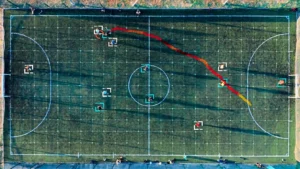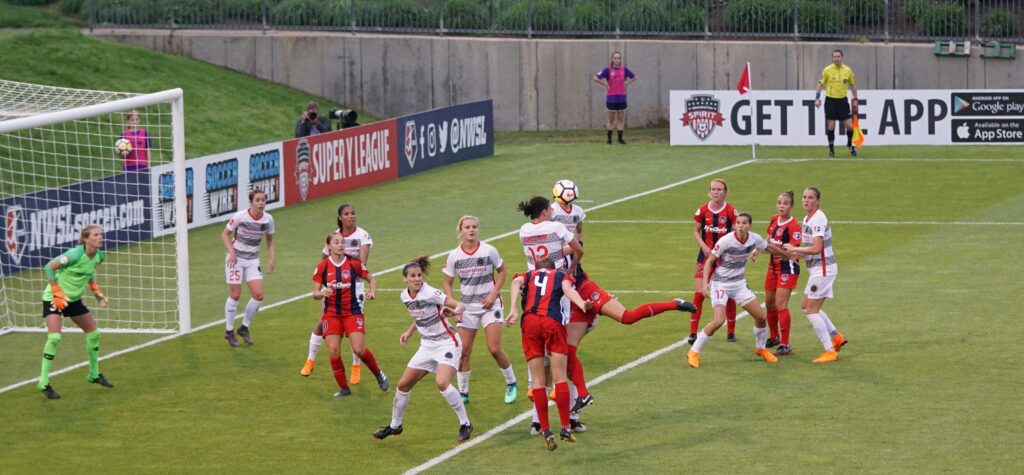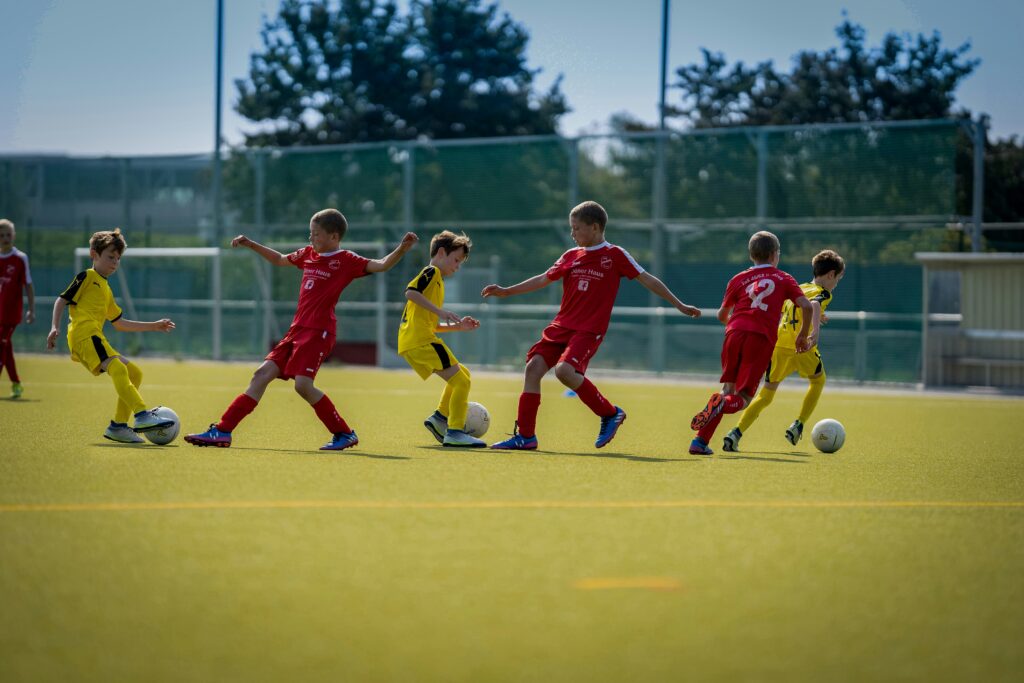
Modern football has gradually transformed itself into a dynamic sport, demanding the need for technological enhancement when it comes to player development and optimization. One of the most underlying but significant advancements in recent times is the use of GPS vests.
Originally, the players only wore these vests during training. Sports scientists, coaches and analysts were eager to analyse the recorded data and evaluate the players' performance. Until the 2015/16 season, FIFA did not allow players to use the wearable technology during matches.
The transition from players wearing the vests on the training pitch to players wearing them during matches was a gradual one. Swansea City were the only team in the Premier League to initially wear the vests in every game. But other teams quickly discovered the benefits. Today, they are an essential part of data collection and a common feature of current football uniform. The coaching staff can use the performance the data collected can be used to objectively assess a player's performance and is no longer dependent on subjective judgements, which can be biased and incorrect.
But what exactly are GPS vest? Let's take a look.
In football, a GPS vest is a wearable device used to measure and monitor several aspects of a player's mobility and physical performance throughout training and matches. They have sensors and GPS devices consisting of advanced algorithms that gather data in real time on several facets of a player's performance. Since the vest normally rests in the space between the shoulder blades, it can properly track movement without getting in the way of the player's movements.

Vest: Players wear a lightweight, form-fitting vest under their shirts that contains the GPS device. Generally, the vest is constructed from a flexible, breathable material for comfort and mobility.
GPS Unit: Typically, the GPS device is positioned in the space between the shoulder blades to deliver the most precise information without obstructing the player's motions.
Player Movement Tracking: The main function of a GPS vest is to track the way a player moves on the field. These metrics include distance covered, speed, acceleration, and deceleration.
Physiological Parameters: The vest also provides an extensive picture of a player’s physical condition. The advanced models can monitor heart rate, body load, and other physiological patterns.
After this important data is collected, it is transmitted into a central system where it can be analyzed by coaches, trainers, and sports scientists, where they put the benefits together.
Performance Analysis: The performance analysis is done by understanding a player’s physical performance, which includes different details such as endurance and distance covered on the pitch. Moreover, other data such as identifying a player’s strengths and weaknesses is also available to coaches. After thorough analysis, coaches can tailor training programs accordingly both tactically and physically. For example, the given data can help with identifying where player’s lacking in their diet as well after training and matches. These statistics also help coaches with scouting, recruiting, and comparison not only with their own progress, but also how they compare with other players.
Injury Prevention: Injuries are prevented when the backroom staff has the player’s biomechanics. Thanks to the vest, these metrics are easily accessible. Not only does it help with the biomechanics, but it also helps analyze other metrics such as workload and exertion, which assists in detecting signs of fatigue or overtraining. In addition, recovery management is also accommodated as recovery and injury prevention are both connected. Understanding a player’s physical output helps in planning a specialized recovery program catered to each individual, ensuring they are rested for future games, ensuring injury prevention, and maximum output for players.
Tactical Insights: In addition to the physical characteristics that vests provide, the information they provide for tactical insights is important. This is done by gaining insight into a player's positioning and movement patterns. This information allows coaches to recognize tactical nuances and not only plan better, but also make better decisions during the game, which can have a positive impact on both the team and the player.
Immediate Feedback (Depending on the type of vest): There are vests that provide real-time feedback due to the live-tracking abilities. This is usually done through a tablet or smartphone, giving coaches and tacticians immediate access to performance analytics.
Although there are several advantages of equipping these GPS football vests, there is one main disadvantage associated with the use of this technology; cost. These football vests can be expensive due to them being of high-quality, especially, when the amount of football vests required is factored into the equation, with most squads consisting of over 25 players, the overall cost could harm many clubs financially. This cost can be detrimental to smaller teams or amateur clubs with limited budgets, who may opt for other solutions when it comes to analysis and catering the money elsewhere in the club. However, there are existing solutions with the technological side of football.

Additionally, there are some glaring problems with using GPS vests in football, especially when used in youth teams, that is if it is appropriate to use them in youth teams. To begin with, collecting and analyzing data at youth level requires time, and most youth team coaches have other responsibilities. They may also not have the knowledge or resources to usefully implement the data generated by these vests.
Young players may also find discomfort in having a vest attached to their body, which could restrict their performance levels, enjoyment of the game, and may even lead them to not participating. This could also then lead to a negative impact on their general development of the game, since self-expression is important to identify yourself as a footballer, especially at a young age. There would be a huge risk in relying on data to find raw talent, which has overseen some magicians, primarily from the South American side of football.
Although technology can be a person’s best friend, it can also be its worst enemy. And there are many possible issues that may arise while using these GPS vests. The first inconvenience when using these vests would be their battery life. Making sure that the vests are charged at all times could be a mission. Moreover, since batteries degrade overtime, they would have to be replaced, which would be an additional cost on top of everything else.
Another burden caused by the GPS vests would be assigning the vests to each respective player. For example, having the right vest for each player every time could cause a human-error, such as the vests being replaced with another player’s vest, which would harm not only the individual itself, but the team as well.
In general, the over-reliance on technology technologyin this case, the GPS vests could be a problem in many ways. Firstly because the technology in these vests requires constant updates, which are necessary for the accuracy of results. Another issue could be with connectivity. Since these vests are usually connected to bluetooth, poor connectivity could lead to inaccurate data.
Alternatives to GPS Vests in Football:
The technology and cameras used by zone14 The technology used and the cameras are an alternative to the expensive GPS vests, which enable positioning in the same way as the vests, but only viaideo. Anstatt ein großes Budget für GPS-Westen zu brauchen, ist es beispielsweise möglich, das teuerste zone14-Paket for less money than it would cost to buy a waistcoat for every single player on a team. To gain meaningful insights, it's important to have both data and video. The usefulness or utility of a sprint can vary depending on context, which can only be seen through video. And although their technology does not currently provide heart rate data, it covers all the other aspects covered by GPS waistcoats. This includes the Heatmaps of the individual players, which also include the number of sprints a player has made and the distance travelled. The player tracking aspect of zone14's AI collects statistics via a sophisticated camera system that allows data to be analysed during and after the game.
The reason why zone14 would be an effective solution for youth teams is because the data provided by zone14 is more on the tactical side. It does track individual data such as the speed of the player, number of sprints made, their heat map, and distance covered, along with analyzing the players with the player-tagging technology. However, the personalized data such as the emphasis on the physiological side will not be included, ensuring safety for youth players.
Maintaining the zone14 technology will not be as big of an issue either because of its simplicity. It is a simple plug-and-play device, with the option to keep in touch with the handlers at all times through WhatsApp. Running into issues such as charging will not be a problem as the camera will only have to be plugged in. Moreover, all of the data captured by zone14 is saved into their web app, where the data is always available to access.
The integration of GPS vests into modern football represents a significant advancement in player development and optimization. These devices provide comprehensive data on player performance, movement, and physical condition, aiding in performance analysis, injury prevention, and tactical planning. However, their high cost can be a barrier for smaller clubs. Zone14 offers a cost-effective alternative with AI-driven sports analytics, providing similar insights through automated video analysis and player tracking without the need for expensive wearable technology. This makes advanced analytics more accessible to a wider range of football teams.
The “sports bras” that are so popular in football are actually GPS or tracking vests that players wear during training and matches. These vests are designed to hold a tiny GPS tracking device that collects various performance indicators.
GPS vests track player movements and physical performance metrics such as distance covered, speed, acceleration, and heart rate to help improve performance and monitor fitness levels.
The vests are lightweight and form-fitting, made from flexible, breathable materials for comfort. The GPS unit is typically positioned between the shoulder blades to track movement accurately without impacting the player's mobility.
They provide detailed data on a player’s endurance, distance covered, speed, and acceleration, helping coaches tailor training programs and identify strengths and weaknesses.
Yes, high-quality GPS vests can be costly, which may be a significant financial burden for smaller or amateur clubs.
While beneficial, they present challenges such as high costs, discomfort for young players, the need for data management expertise, and privacy concerns.
